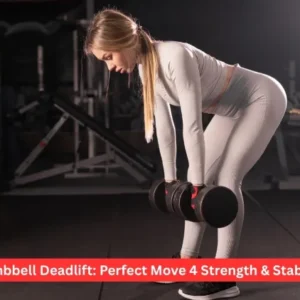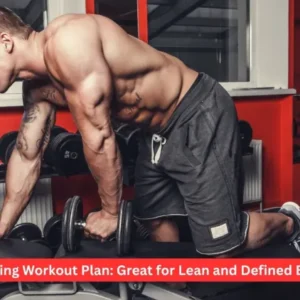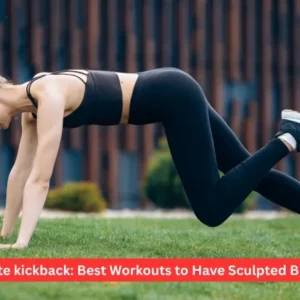If you’re stuck at home with minimal equipment, not fond of crowded gyms, or simply want to add some serious strength training to your workout, the kettlebell shoulder press is an excellent choice.
The shoulder press is essential for a full-body workout. It’s a functional movement that strengthens not only your upper body but also your core, all the way down to the ground. The kettlebell press, in particular, offers several benefits over traditional barbell exercises.
Kettlebell Press Exercises & Variations
Kettlebell Push Press
In the strict press, your only movement is to raise the kettlebell. Push press uses your legs to use explosive power to push the weight upwards. The technique allows you to lift more weight (about 30%).
Start with the kettlebell in its rack position. You will need to slightly bend your knees and push your feet down into the ground. Then, you will need to extend your hips explosively in order for the bells to be overhead.
Seesaw Press
The seesaw press can be a challenging and fun variation. This variation is an alternate kettlebell press, where you lift one kettlebell while holding the other side down. You should master the single kettlebell presses before you can move on to other double kettlebell exercises like cleans and squats.
Kettlebell Kneeling and Half-Kneeling Press
These variations activate your core effectively because they do not rely on your legs for the movement. Kneel on your knees with your spine straight, glutes tight, and abs engaged. Press the kettlebell overhead with either one or both of your hands.
Kettlebell Floor Press
For the kettlebell press, you should lie on your stomach with the kettlebell placed at chest height. Lift the kettlebell with both hands, then press up the kettlebell while keeping your core engaged.
Bottom-Up Kettlebell Press
To perform the bottom-up press, you must hold the kettlebell upside-down by the handle. This position helps you develop a better pressing path and a firmer grip on your bell. Lower the weight if your wrist bends or flutters your elbow. Focus on perfecting your movement.
Benefits of the Kettlebell Press
The offset nature of the single-arm kettlebell press and the shape of the kettlebell itself make it stand out in strength training. A double-arm kettlebell press, apart from the obvious benefit of pressing heavier weight, also challenges your ability to stabilize the kettlebell in each hand throughout the movement. Your shoulders and rotator cuff muscles (which keep your shoulder joint secure) will work hard to balance and stabilize the kettlebell.
Unlike dumbbells or barbells, kettlebells require you to hold the weight in a very different position—on the back of your arm, which helps strengthen your wrist.
Additionally, the kettlebell press allows for a more natural arm movement. When pressing the kettlebell from the rack position overhead, your arm moves like a screwdriver (rather than a “high five” motion), which reduces stress on the shoulder, elbows, and wrists.
There are many variations of the kettlebell press, including single-arm, double-arm, standing, seated, kneeling, strict, push, seesaw, and bottom-up. A standing kettlebell press allows for heavier weight, while seated variations require more core strength and flexibility.
Performing the kettlebell press improves body alignment. If you don’t press the bell in a straight line, it can throw you off balance. It also strengthens eccentric strength, which translates to better performance in other kettlebell and non-kettlebell movements, as well as daily activities.
Muscles Worked in a Kettlebell Press
Surprisingly, the kettlebell press is not just a shoulder exercise. It’s a full-body movement that activates muscles from your feet to your upper body and arms.
No matter whether you’re doing a standing, sitting, or kneeling kettlebell press, you’ll engage various muscles:
Deltoids (shoulders)
Rotator cuff
Upper chest
Upper back (lats and traps)
Triceps
Forearms (wrist flexors and extensors)
Serratus anterior (the “boxer’s muscle”)
Core
Glutes
Hamstrings
Kettlebell Press Form
The kettlebell press is simple: take it and press it. But to avoid injury and get the most out of the exercise, good form is essential.
Here are the steps for the classic kettlebell press (also known as the kettlebell military press or kettlebell overhead press):
- Clean the kettlebell into the rack position: Start with your upper arm tucked to your chest. Your wrist should be above your forearm and face the midline of your body. Brace your core and squeeze your glutes. You can extend the opposite arm to help balance the weight. This posture is your starting position.
- Press the kettlebell overhead: Press the kettlebell in a straight line up to the overhead lockout position. Keep your shoulder blades back and down—never let your shoulder rise. Rotate your wrist slightly so that your palm faces forward when the bell is overhead.
- Engage your body: Lock your legs, tighten your glutes, and engage your core. Your entire body should feel solid like a “standing plank.”
- Lower the kettlebell back to the rack position: Do not drop it. Instead, pull it down actively by squeezing your lats. Keep your knuckles facing up, and avoid resting the bell on your shoulder.
Common Mistakes and How to Avoid Them
- Moving the bell off-center: When pressing the kettlebell, keep it close to your body’s center to avoid shoulder strain. The closer the bell is to your center of mass, the safer and more effective the press.
- Not engaging your core: The kettlebell press is a full-body movement. Keep your core tight, feet planted, and glutes squeezed. Avoid slouching, bending backward, or tilting to the sides.
- Inefficient breathing: Take a deep breath before pressing the kettlebell. Exhale slowly as you push it overhead. When the kettlebell is locked overhead, inhale, then exhale as you bring the kettlebell down.
- Not pressing enough: To master the kettlebell press and see real results, you need to practice it regularly.
Final Thoughts
Kettlebell press is a great exercise for building strength, stability, and coordination. You can improve your fitness by incorporating different variations in your workout. Start with the basics and master the form. Then, progress. It’s time to press!
FAQs: Kettlebell press
1. What muscles is the kettlebell exercise targeting?
The kettlebell exercise targets the deltoids, rotator cuffs, upper chest, upper back, triceps, and forearms, as well as the serratus anterior. It also works the core, glutes, and hamstrings.
2. How can I avoid making common mistakes when doing the kettlebell press?
For a perfect technique, avoid making common mistakes. Keep the kettlebell near your center of mass. Engage your core during the entire movement. Maintain proper breathing.
3. What is the difference between kettlebell presses and push presses?
The kettlebell press only uses your upper body, while the press press utilizes your explosive power to press the kettlebell overhead. This allows you to lift heavier loads.
4. How often should I do the kettlebell press to get maximum results?
For significant results, you should practice the kettlebell presses regularly. Aim for at least 2-3 sessions per week. The key to building muscle and strength is consistency, along with the proper form.







